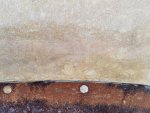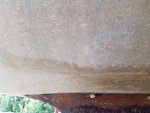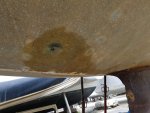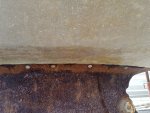yno
New member
Hello,
I suspect I might have parts of my fiberglass hull soaked with diesel. Although it is still unclear to me how exacly it got there, and if it did at all, the fact is that I had diesel sitting in the bilge for several months (away from the boat, couldnt check regularly), and there are strains on the outside. It feels oily to the touch, hence my assumption of it being diesel.
I peeled the gelcoat a year ago in an attempt to dry any moisture and left the boat outside. Other parts being affected by this phenomenon are a couple of holes where thruhulls used to be, although from the inside I hardly see any way for the diesel to get there, so maybe it is just water (but feels oily as well, weird).
Although I dont know whether diesel compromises the mechanical properties of the fiberglass (a study performed on aircraft fuels has found very little strengh loss, but wasnt performed with diesel Influence of Fuel Absorption on the Mechanical Properties of Glass-Fiber-Reinforced Epoxy Laminates ), I am pretty sure it prevents any barrier coat or extra layers of laminate to stick to the hull. So far I emptied the fuel tank and cleaned the bilge.
If any of you has any suggestion on how to dry the hull or what needs to be done, it would be really appreciated, thanks.
I suspect I might have parts of my fiberglass hull soaked with diesel. Although it is still unclear to me how exacly it got there, and if it did at all, the fact is that I had diesel sitting in the bilge for several months (away from the boat, couldnt check regularly), and there are strains on the outside. It feels oily to the touch, hence my assumption of it being diesel.
I peeled the gelcoat a year ago in an attempt to dry any moisture and left the boat outside. Other parts being affected by this phenomenon are a couple of holes where thruhulls used to be, although from the inside I hardly see any way for the diesel to get there, so maybe it is just water (but feels oily as well, weird).
Although I dont know whether diesel compromises the mechanical properties of the fiberglass (a study performed on aircraft fuels has found very little strengh loss, but wasnt performed with diesel Influence of Fuel Absorption on the Mechanical Properties of Glass-Fiber-Reinforced Epoxy Laminates ), I am pretty sure it prevents any barrier coat or extra layers of laminate to stick to the hull. So far I emptied the fuel tank and cleaned the bilge.
If any of you has any suggestion on how to dry the hull or what needs to be done, it would be really appreciated, thanks.




